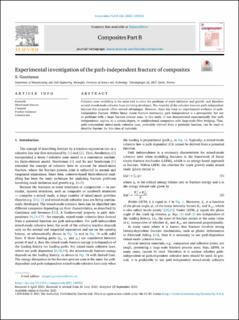| dc.contributor.author | Goutianos, Stergios | |
| dc.date.accessioned | 2021-11-02T09:38:38Z | |
| dc.date.available | 2021-11-02T09:38:38Z | |
| dc.date.created | 2021-10-15T09:24:58Z | |
| dc.date.issued | 2021 | |
| dc.identifier.citation | Composites Part B: Engineering. 2021, 226 . | en_US |
| dc.identifier.issn | 1359-8368 | |
| dc.identifier.uri | https://hdl.handle.net/11250/2827208 | |
| dc.description.abstract | Cohesive zone modelling is the main tool to solve the problems of crack initiation and growth, and therefore several mixed-mode cohesive laws are being developed. The majority of the cohesive laws are path independent because this property offers several advantages. However, there has been no experimental evidence of path-independent fracture. Within linear elastic fracture mechanics, path independence is a prerequisite, but not in problems with a large fracture process zone. In this study, it was demonstrated experimentally that path independence applies, to a certain degree, to unidirectional composites with large-scale fibre bridging. Thus, path-independent mixed-mode cohesive laws, preferably derived from a potential function, can be used to describe fracture for this class of materials. | en_US |
| dc.language.iso | eng | en_US |
| dc.publisher | Elsevier | en_US |
| dc.rights | Navngivelse 4.0 Internasjonal | * |
| dc.rights.uri | http://creativecommons.org/licenses/by/4.0/deed.no | * |
| dc.title | Experimental investigation of the path-independent fracture of composites | en_US |
| dc.type | Peer reviewed | en_US |
| dc.type | Journal article | en_US |
| dc.description.version | publishedVersion | en_US |
| dc.source.pagenumber | 10 | en_US |
| dc.source.volume | 226 | en_US |
| dc.source.journal | Composites Part B: Engineering | en_US |
| dc.identifier.doi | 10.1016/j.compositesb.2021.109352 | |
| dc.identifier.cristin | 1946117 | |
| cristin.ispublished | true | |
| cristin.fulltext | original | |
| cristin.qualitycode | 2 | |

